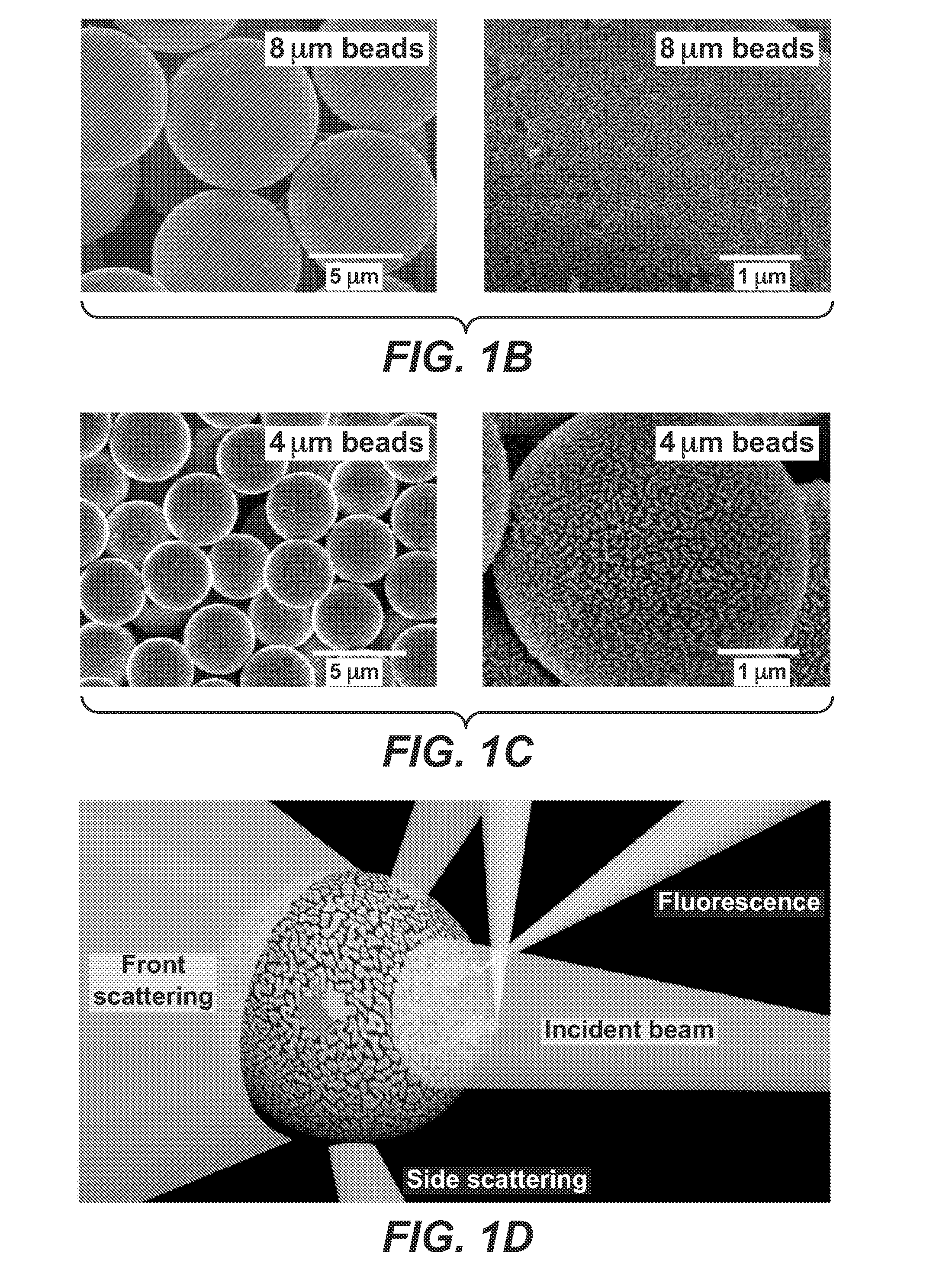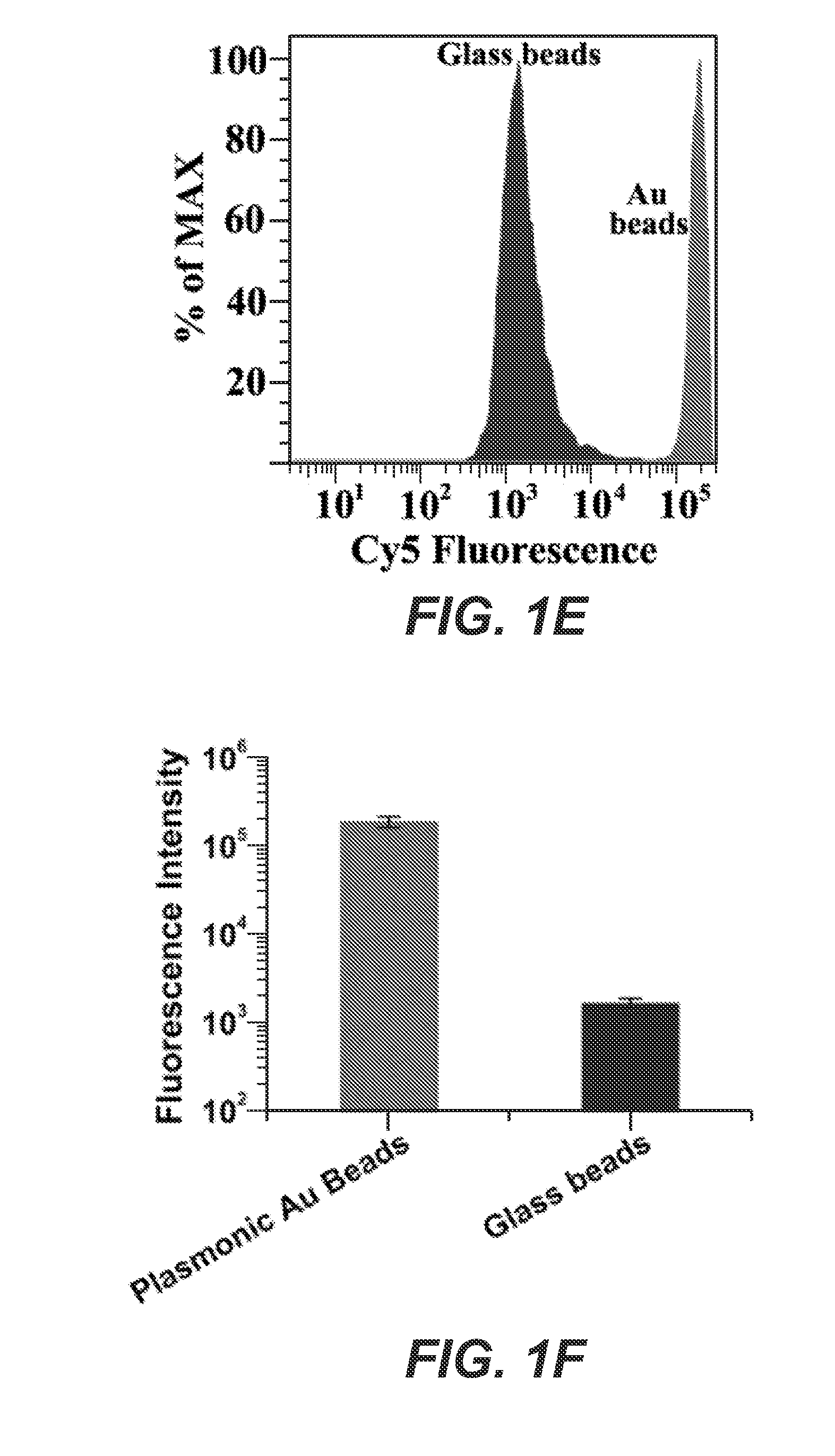Plasmonic beads for multiplexed analysis by flow detection systems
a technology of flow detection and plasmonic beads, which is applied in the field of analyte detection, microparticles or beads in suspension, flow cytometry, surface plasmon resonance and metalenhanced fluorescence, and multiplexed immunoassays. it can solve the problems of not being recommended for use with conventional epifluorescence microscopes, not being able to optimally excite with mercury lamps, and not being able to see well by eye. it improves the fluorescen
- Summary
- Abstract
- Description
- Claims
- Application Information
AI Technical Summary
Benefits of technology
Problems solved by technology
Method used
Image
Examples
example 1
Producing Plasmonic Gold Beads
[0088]Plasmonic gold coated silica beads were prepared through a two-step seeding-and-growth approach18. First, glass beads (8 μm or 4 μm in diameter) were modified with amine groups through reaction with [3-(2-aminoethylamino)propyl]trimethoxysilane (AEPTS). The amine modified glass beads were introduced to a HAuCl4 solution followed by adding ammonium hydroxide (see methods), resulting in [Au(OH)x(NH3)yClz]mn+ clusters attaching to amine modified glass beads. The clusters were then reduced to gold nanoparticles (gold seeds) by sodium borohydride. Growth of gold on the seed particles was performed by introducing the gold seeded glass beads into a solution composed of HAuCl4 and NH2OH for reducing Au(III) selectively on the gold seeds on the bead by NH2OH. The color of the resulting bead solution is blue-purple, correlating with red and near-infrared plasmonic absorption of the bead. Scanning electron microscopy (SEM) revealed that the gold coating on t...
example 2
Fluorescence Enhancement of Near-Infrared Fluorophore on Plasmonic Beads
[0089]We investigated the fluorescence enhancement of gold coated beads with various coating morphology by absorbing Cy5-avidin onto the beads via non-specific binding. Cy5-avidin was also absorbed on glass beads for comparison. The Cy5 fluorescence intensity (peak˜670 nm) on plasmonic beads and on glass beads were quantified by flow cytometry (FIG. 1D). A vial containing 100,000 Cy5-avidin coated plasmonic beads was placed in a flow cytometer, with each individual bead passed through a micro fluidic channel for detection of front scattering and side scattering using an incident 488 nm laser. Simultaneously, Cy5 fluorophores on the bead were excited with a 640 nm laser with its fluorescence emission recorded.
[0090]We observed that at low growth concentration of HAuCl4 (<50 μM), discrete gold nanoparticles were formed on glass beads, giving low NIR-FE effects (FIG. 6A-6B and FIG. 7A-7B). As the growth concentrati...
example 3
Plasmonic Gold Beads for Single Cytokine Detection
[0091]The 8 micron gold plasmonic beads were coated with avidin and then biotinylated capture antibody specific to the human cytokine IL-6. After blocking with biotinylated branched polyethylene glycol (PEG) and fetal bovine serum (FBS), the beads were distributed into multiple vials with ˜5000 beads in each vial. Serially diluted human cytokine IL-6 solutions from 1 nM to 10 fM plus a blank control were added to each vial of bead modified with anti-human IL-6 capture antibody. After equilibration, washing and incubation with fluorophore Cy5 labeled anti human IL-6 detection antibody (FIG. 2A), ˜1000 beads in each vial were counted by flow cytometry with Cy5 fluorescence intensity measured for each concentration of IL-6 (FIG. 2B-2C). We observed 7 orders of magnitude dynamic range in IL-6 detection, spanning from 1 nM IL-6 down to 10 fM using 100 μL solution. The calculated low limit of detection of human IL-6 by the plasmonic bead a...
PUM
| Property | Measurement | Unit |
|---|---|---|
| area | aaaaa | aaaaa |
| area | aaaaa | aaaaa |
| area | aaaaa | aaaaa |
Abstract
Description
Claims
Application Information
 Login to View More
Login to View More - R&D
- Intellectual Property
- Life Sciences
- Materials
- Tech Scout
- Unparalleled Data Quality
- Higher Quality Content
- 60% Fewer Hallucinations
Browse by: Latest US Patents, China's latest patents, Technical Efficacy Thesaurus, Application Domain, Technology Topic, Popular Technical Reports.
© 2025 PatSnap. All rights reserved.Legal|Privacy policy|Modern Slavery Act Transparency Statement|Sitemap|About US| Contact US: help@patsnap.com



